Environmental Geochemistry of Copper
| ✅ Paper Type: Free Essay | ✅ Subject: Sciences |
| ✅ Wordcount: 2733 words | ✅ Published: 15 Sep 2017 |
Nwankwo Chihurumnanya Belema
February, 2017
This report was aimed at providing an insight into the environmental geochemistry of copper (Cu). It gave a brief overview of the occurrence of copper and areas in which it is located globally. It went on to discuss its various physical and chemical properties, after which it evaluated the extraction and processing techniques which are used to recover Cu. The diverse uses of Cu in various industries were also looked at, and then the wastes generated during the Cu processing were discussed. The vast routes of Cu pollution in the environment were also analysed, and the toxicity of Cu in humans, animals, aquatic species and micro-organisms were appraised. Lastly, the standards put together to curb Cu exposure and toxicity were equally identified.
The quantity of copper beneath the Earth’s surface is approximately 50 parts per million (ppm) and it occurs as large star-like structures (Emsley, 2011). It takes different natural forms in the likes of cuprite which is a copper(I)oxide mineral, malachite and azurite which are copper carbonates, as well as chalcocite and chalcopyrite which are copper sulphides (McLemore & Mullen, 2004). These various copper-bearing minerals and their distinctive copper percentages are shown in Figure 1. It is argued that the distribution of Cu and Zinc (Zn) are quite similar to that of Pb (Lead) (Franklin, Gibson, Jonasson, & Galley, 2005), however, further studies show that this is majorly predominant in roadside soils (Bakirdere & Yaman, 2008). In the current advancing world, recycling has proven to be a reliable alternate source of copper (Gomez, Guzman, & Tilton, 2007). Another key source of copper is skarns, which form by hydrothermal fluid reactions in high temperature igneous environments, usually above 2500C (Hammarstrom, 2002).

Figure 1. Various copper-bearing minerals and their copper percentages (Emsley, 2011).
2.1 EXTRACTION
Copper is normally extracted or mined in the form of copper sulphides in 0.4 -1.0% Cu-containing porphyry copper deposits from massive open pit mines (Melchiorre & Enders, 2003), as shown in Appendix A-1. Various mining sites of copper around the world include the USA which has the El Chino Mine in New Mexico and the Bingham Canyon Mine in Utah, as well as Chuquicamata in Chile (Crowson, 2012). In 2005, the British Geological Survey highlighted that Chile produced about one-third of the world’s copper, making them the top copper producer globally in front of USA, Indonesia and Peru respectively (Nishiyama, 2005) as seen in Appendix A-2. An in-situ heap leaching process is one feasible technique for copper recovery, as most sites in Arizona have implemented this technique with recorded successes (Dreisinger, 2006). Since the inception of copper extraction for thousands of years, the last two decades have accounted for more than half of copper extraction (Martinez-Alier, 2001). It is proposed that over 1014 tons of copper exists in the Earth crust’s top kilometre which could last up to 5 million years based on current extraction rates. Nonetheless, the extraction of these vast reserves of copper is limited by current technologies and prices, making only a little portion of it to be economically feasible to exploit (Camus & Dilles, 2001).
2.2 PROCESSING
It is typical for the ore in mining operations to be concentrated, thereby making the processing methods to be dependent on the nature of the ore (Sadowski, Jazdzyk, & Karas, 2003). Ores like chalcopyrite which are sulphide copper minerals are usually crushed and ground to release the important minerals from the waste, and then beneficiated using mineral flotation (Peng, Grano, Fornasiero, & Ralston, 2003). The next process involves smelting the sulphide concentrates in furnaces to yield matte, which is then converted and refined to give anode copper before the last stage of electrolysis comes in (Biswas & Davenport, 2013). Due to environmental and economic factors, there is always a reclamation of the by-products during the processing of copper, just like the turning of sulphur dioxide into sulphuric acid (Agrawal, Sahu, & Pandey, 2004). Any copper ores which are oxidised during the refining process are treated through hydrometallurgical extraction (Biswas et al, 2013). A flowchart of the extraction, processing and manufacturing is shown in Figure 2.
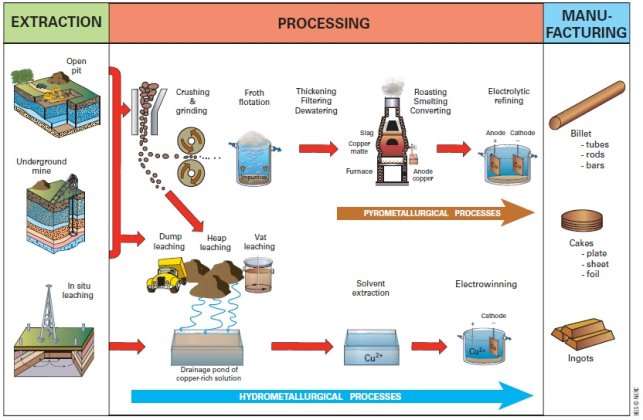
Figure 2. A flowchart illustrating copper extraction, processing and manufacturing (BGS, 2007).
2.3 PROPERTIES
Copper is the 29th element on the periodic table in Group 11 with symbol Cu, and it is a ductile, malleable and soft metal that possesses high electrical (59.6×106 S/m) and thermal conductivity (401 W/(m.K) (BGS, 2007). Native copper usually has a reddish-orange colour when exposed to air as shown in Figure 3. It has a face-centred cubic crystalline structure, with density of 8.96 g/cm3 at room temperature (Núñez Aguilar, 2013). This solid element has a boiling point of 2567 0C and melting point of 1083 0C (BGS, 2007). Copper reacts with oxygen when exposed to air to form a protective layer of copper-oxide, which prevents the metal from corrosion, unlike in iron (Fe) (Balamurugan & Mehta, 2001). Various alloys of copper exist including brass (copper and zinc) and bronze (copper and tin), amongst many others (BGS, 2007).

Figure 3. Native copper in its natural form (BGS, 2007).
2.4 USES
60% of copper is used for electrical wires and cables, 20% for plumbing and roofing, 15% for industrial equipment and 5% for use as alloys of bronze and brass (Ayres, Ayres, & Råde, 2003) as seen in Figure 4 and Appendix A-3. It is also used as an antibiofouling agent to regulate plant and shellfish growth, and also has antimicrobial function as fungicides and nutritional supplements in the agricultural sector (Pelletier, Bonnet, & Lemarchand, 2009). Its use also cuts across folk medicine for bracelets that relieve arthritis, as well as its use for compression clothing suggested to treat certain ailments (Richmond, 2008). It also serves as a wood preservative, musical instruments, especially the brass instruments like gongs and string instruments like guitars and pianos (Sachs, 2012). Its use is also predominant in the beverage industry for distilling spirits like whisky (Lu & Gibb, 2008).

Figure 4. Various uses of copper in different industries. Data from (CDA, 2016).
2.5 DISCARDING
Copper could be recycled from its raw state and also from produced materials, and it ranks as the third most recycled metal behind iron and aluminium as seen in Figure 5 (Agrawal et al., 2004). About 80% of all globally extracted copper is still in use currently, probably because the recycling process is similar to the extraction process, only with the exception of few steps (Biswas et al, 2013). Scrap copper of high purity is melted in a furnace, and afterwards reduced and cast into ingots and billets; while those of lower purity are electroplated in sulphuric acid (BGS, 2007). Certain bacteria like Pseudomonas fluorescens and Chromobacterium violaceum aid in copper degradation (Faramarzi, Stagars, Pensini, Krebs, & Brandl, 2004).
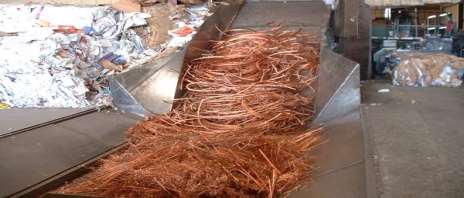
Figure 5. Discarding of copper in recycling unit (Giordano’s Recycling, 2012).
2.6 WASTE
Slag wastes, as shown in Figure 6 are usually the by-products after copper refining processes, and the Sarcheshmeh Copper Complex in Iran produces over 370,000 tons of slag waste annually (Khorasanipour & Esmaeilzadeh, 2016). These slag wastes are deemed to be multi-elemental contaminants with very high toxicity, and pose anthropogenic risks to the natural environments (Ashley, Lottermoser, & Chubb, 2003). However, in weathering environments, their toxicity is somewhat reduced as low soluble glass compounds, oxides and silicates encapsulate them (Khorasanipour et al, 2016). These slags act as environmental contaminants through leaching and weathering processes of potentially toxic elements (Luo, Yu, Zhu, & Li, 2012). It is suggested that 1 ton of copper could generate about 2.2 – 3 tons of slag waste, and worldwide copper slag production is about 24.6 million tons (Hammarstrom, 2002). However, smelting slag wastes serve as useful additives for abrasive, construction and building materials (BGS, 2007).

Figure 6. A piece of copper slag waste (CDA, 2016).
2.7 POLLUTION
Due to continuous increase in global copper production, more copper ends up in the environment as shown in Figure 7 (BGS, 2007). Wastewater that have copper have been deposited at the river banks while the air has also been polluted with copper through combusting fossil fuels (Luo et al., 2012). These copper held up in the air then fall back as rain, alongside dumped slag waste which then contaminate the soil (Wong, Li, & Thornton, 2006). Some natural routes of copper pollution are sea spray, forest fires, decaying vegetation and wind-blown dust (Ashley et al., 2003). Human contributions include mining, as well as phosphate fertilizer, metal and wood production (Raufflet, Barin Cruz, & Bres, 2014).

Figure 7. Environmental effect of copper pollution (123RF, 2016).
2.8 TOXICITY
Copper levels above 2.0 mg/l in drinking water is suggested to be lethal to humans as highlighted in Figure 8, however, this also depends on the source of contamination (Zietz et al., 2003). It could cause eye irritation, lung disease, dermatitis, upper respiratory tract infection, acute renal failure, liver damage and death in humans (Blanusa, et al, 2005). The oligodynamic effect poses toxicity to bacteria in even little levels of copper (Shrestha, et al, 2009). For aquatic species, it affects their nervous system, kidney, liver and gills, as well as their sense of smell which hinders their usual mating process (Kiaune & Singhasemanon, 2011).
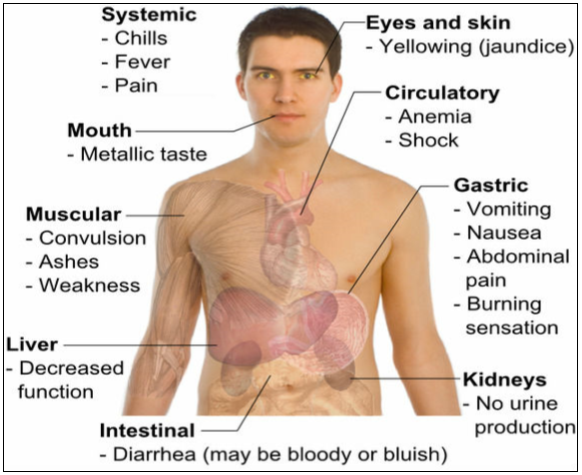
Figure 8. Major symptoms of copper poisoning in the human body (Asian Metal, 2016).
2.9 STANDARDS
There are several standards and specifications that are necessary for proper handling and exposure to copper (BGS, 2007). Amongst these are the Unified Numbering System (UNS), as well as ASTM Standard Designation for Wrought and Cast Copper and Copper Alloys (CDA, 2016). The permissible exposure limit (PEL) of 1 mg/m3 time-weighted average (TWA) for copper dusts is being set by the Occupational Safety and Health Administration (OSHA), which also tallies with the recommended exposure limit set by National Institute for Occupational Safety and Health (NIOSH) (OSHA, 2016). However, the level that is immediately dangerous to life and health (IDLH) is 100 mg/m3 TWA (Fthenakis, 2003). For copper fumes, the OSHA and NIOSH exposure limits are set at 0.1 mg/m3 TWA (Coble, Lees, & Matanoski, 2001), however, the American Conference of Governmental Industrial Hygienists (ACGIH) sets their threshold limits at 0.2 mg/m3 TWA (Cohen & Powers, 2000).
Copper is normally a reddish-orange polycrystalline, ductile, malleable and soft metal with high electrical and thermal conductivity (Ayres et al., 2003). It could be extracted from various minerals, as well as skarn deposits, landfills, waste dumps and open pit mines (Emsley, 2011). The use of copper also spans across the electrical, architectural, plumbing, industrial, jewelry, agro-allied, microbiological, music and beverage industries (CDA, 2016). The major method through which copper could be discarded is deemed to be recycling, although certain bacteria aid in its mobilization (Agrawal et al., 2004). The processing of copper also involves several stages that cut across crushing, grinding, mineral flotation, smelting, conversion, refining and finally electrolysis (Peng et al., 2003). At the end of these processes, slag wastes are generated and have the potential to cause damage to the environment (Khorasanipour et al, 2016). It has also been found to be very toxic in humans and animals, causing damage to the liver, skin, lungs and kidney (Zietz et al., 2003). To this effect, OSHA and NIOSH are two of many other organizations that have set certain standards and exposure limits to curb its toxic effects (OSHA, 2016).
After gaining an understanding of the environmental geochemistry of copper, it can be seen that its exploitation and mining remain very vital for daily activities in various sectors. However, the standards that have been set by OSHA and NIOSH should be taken into consideration to mitigate any environmental and health impacts that may be associated with its exposure. Furthermore, regions with very high copper reserves like Chile should also ensure that mine sites are effectively protected from having direct contact with the environment.
References
123RF. (2016). Contaminated mine water pollution of a copper mine exploitation. Retrieved from https://www.123rf.com/photo_24914808_contaminated-mine-water-pollution-of-a-copper-mine-exploitation.html
Agrawal, A., Sahu, K., & Pandey, B. (2004). Solid waste management in non-ferrous industries in India. Resources, Conservation and Recycling, 42(2), 99-120.
Ashley, P. M., Lottermoser, B. G., & Chubb, A. J. (2003). Environmental geochemistry of the Mt Perry copper mines area, SE Queensland, Australia. Geochemistry: Exploration, Environment, Analysis, 3(4), 345-357. https://doi.org/10.1144/1467-7873/03-014
Ayres, R. U., Ayres, L. W., & Råde, I. (2003). Copper: Demand and Disposition. In The Life Cycle of Copper, Its Co-Products and Byproducts (pp. 59-100). Springer.
Bakirdere, S., & Yaman, M. (2008). Determination of lead, cadmium and copper in roadside soil and plants in Elazig, Turkey. Environmental Monitoring and Assessment, 136(1-3), 401-410.
Balamurugan, B., & Mehta, B. (2001). Optical and structural properties of nanocrystalline copper oxide thin films prepared by activated reactive evaporation. Thin Solid Films, 396(1), 90-96.
BGS. (2007). Copper. Retrieved from www.bgs.ac.uk/downloads/start.cfm?id=1410
Biswas, A. K., & Davenport, W. G. (2013). Extractive Metallurgy of Copper: International Series on Materials Science and Technology (Vol. 20). Elsevier.
Blanusa, M., Varnai, V. M., Piasek, M., & Kostial, K. (2005). Chelators as antidotes of metal toxicity: therapeutic and experimental aspects. Current Medicinal Chemistry, 12(23), 2771-2794.
Camus, F., & Dilles, J. H. (2001). A special issue devoted to porphyry copper deposits of northern Chile. Economic Geology, 96(2), 233-237.
CDA. (2016). Copper Applications. Retrieved from https://www.copper.org/applications/
Coble, J. B., Lees, P. S., & Matanoski, G. (2001). Time trends in exposure measurements from OSHA compliance inspections of the pulp and paper industry. Applied Occupational and Environmental Hygiene, 16(2), 263-270.
Cohen, H. J., & Powers, B. J. (2000). Particle size characterizations of copper and zinc oxide exposures of employees working in a nonferrous foundry using cascade impactors. AIHAJ-American Industrial Hygiene Association, 61(3), 422-430.
Crowson, P. (2012). Some observations on copper yields and ore grades. Resources Policy, 37(1), 59-72.
Dreisinger, D. (2006). Copper leaching from primary sulfides: Options for biological and chemical extraction of copper. Hydrometallurgy, 83(1), 10-20.
Emsley, J. (2011). Nature’s building blocks: an AZ guide to the elements. Oxford University Press.
Faramarzi, M. A., Stagars, M., Pensini, E., Krebs, W., & Brandl, H. (2004). Metal solubilization from metal-containing solid materials by cyanogenic Chromobacterium violaceum. Journal of Biotechnology, 113(1), 321-326.
Franklin, J. M., Gibson, H., Jonasson, I., & Galley, A. (2005). Volcanogenic massive sulfide deposits. Economic Geology 100th Anniversary Volume, 98, 523-560.
Fthenakis, V. M. (2003). Overview of potential hazards. Practical Handbook of Photovoltaics: Fundamentals and Applications, 2.
Giordano’s Recycling. (2012). New Jersey Non-Ferrous Metals Recycling Service. Retrieved from http://www.giordanosrecycling.com/non-ferrous-metals.php
Gomez, F., Guzman, J. I., & Tilton, J. E. (2007). Copper recycling and scrap availability. Resources Policy, 32(4), 183-190.
Hammarstrom, J. M. (2002). Environmental geochemistry of skarn and polymetallic carbonate-replacement deposit models.
Khorasanipour, M., & Esmaeilzadeh, E. (2016). Environmental characterization of Sarcheshmeh Cu-smelting slag, Kerman, Iran: Application of geochemistry, mineralogy and single extraction methods. Journal of Geochemical Exploration, 166, 1-17. https://doi.org/10.1016/j.gexplo.2016.03.015
Kiaune, L., & Singhasemanon, N. (2011). Pesticidal copper (I) oxide: environmental fate and aquatic toxicity. In Reviews of Environmental Contamination and Toxicology Volume 213 (pp. 1-26). Springer.
Lu, S., & Gibb, S. W. (2008). Copper removal from wastewater using spent-grain as biosorbent. Bioresource Technology, 99(6), 1509-1517.
Luo, X., Yu, S., Zhu, Y., & Li, X. (2012). Trace metal contamination in urban soils of China. Science of The Total Environment, 421–422, 17-30. https://doi.org/10.1016/j.scitotenv.2011.04.020
Martinez-Alier, J. (2001). Mining conflicts, environmental justice, and valuation. Journal of Hazardous Materials, 86(1), 153-170.
McLemore, V. T., & Mullen, K. E. (2004). Mineral resources in Taos County, New Mexico. New Mexico Geological Society, Guidebook, 55, 383-390.
Melchiorre, E. B., & Enders, M. S. (2003). Stable isotope geochemistry of copper carbonates at the Northwest Extension Deposit, Morenci district, Arizona: implications for conditions of supergene oxidation and related mineralization. Economic Geology, 98(3), 607-621.
Nishiyama, T. (2005). The roles of Asia and Chile in the world copper market. Resources Policy, 30(2), 131-139.
Núñez Aguilar, C. (2013). Microstructure and properties of copper deformed by accumulative roll-bonding.
OSHA. (2016). Copper dusts and mists (as Cu). Retrieved from https://www.osha.gov/dts/chemicalsampling/data/CH_229300.html
Pelletier, É., Bonnet, C., & Lemarchand, K. (2009). Biofouling growth in cold estuarine waters and evaluation of some chitosan and copper anti-fouling paints. International Journal of Molecular Sciences, 10(7), 3209-3223.
Peng, Y., Grano, S., Fornasiero, D., & Ralston, J. (2003). Control of grinding conditions in the flotation of chalcopyrite and its separation from pyrite. International Journal of Mineral Processing, 69(1), 87-100.
Raufflet, E., Barin Cruz, L., & Bres, L. (2014). An assessment of corporate social responsibility practices in the mining and oil and gas industries. Journal of Cleaner Production, 84, 256-270. https://doi.org/10.1016/j.jclepro.2014.01.077
Richmond, S. J. (2008). Magnet therapy for the relief of pain and inflammation in rheumatoid arthritis (CAMBRA): A randomised placebo-controlled crossover trial. Trials, 9(1), 1.
Sachs, C. (2012). The history of musical instruments. Courier Corporation.
Sadowski, Z., Jazdzyk, E., & Karas, H. (2003). Bioleaching of copper ore flotation concentrates. Minerals Engineering, 16(1), 51-53.
Shrestha, R., Joshi, D. R., Gopali, J., & Piya, S. (2009). Oligodynamic action of silver, copper and brass on enteric bacteria isolated from water of Kathmandu Valley. Nepal Journal of Science and Technology, 10, 189-193.
Wong, C. S. C., Li, X., & Thornton, I. (2006). Urban environmental geochemistry of trace metals. Environmental Pollution, 142(1), 1-16. https://doi.org/10.1016/j.envpol.2005.09.004
Zietz, B. P., Dieter, H. H., Lakomek, M., Schneider, H., Keßler-Gaedtke, B., & Dunkelberg, H. (2003). Epidemiological investigation on chronic copper toxicity to children exposed via the public drinking water supply. Science of the Total Environment, 302(1), 127-144.
APPENDIX A-1. Types of Copper Deposits
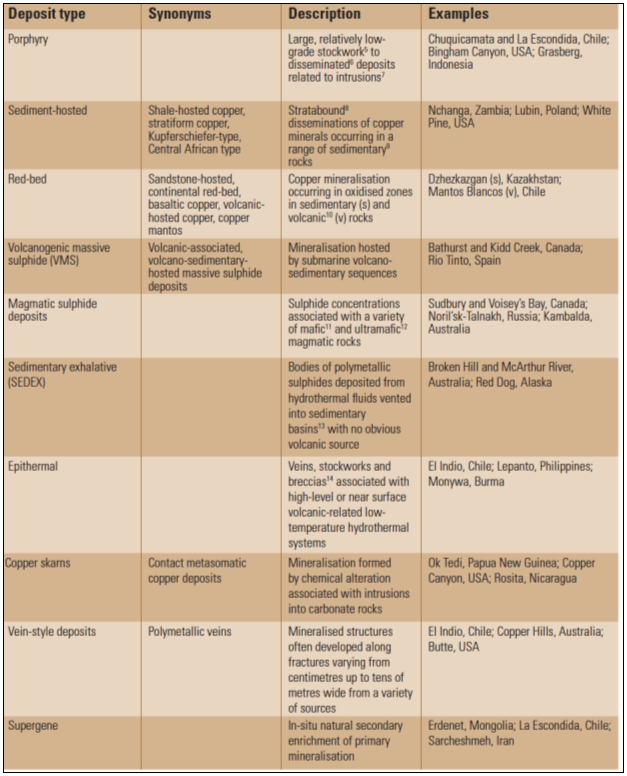
Source: (BGS, 2007)
APPENDIX A-2. TOP COPPER PRODUCING COUNTRIES IN THE WORLD
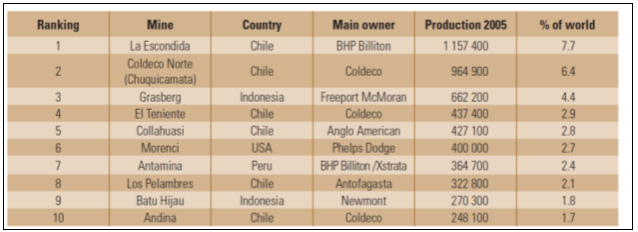

Source: (BGS, 2007)
APPENDIX A-3. APPLICATION OF COPPER IN VARIOUS INDUSTRIAL SECTORS
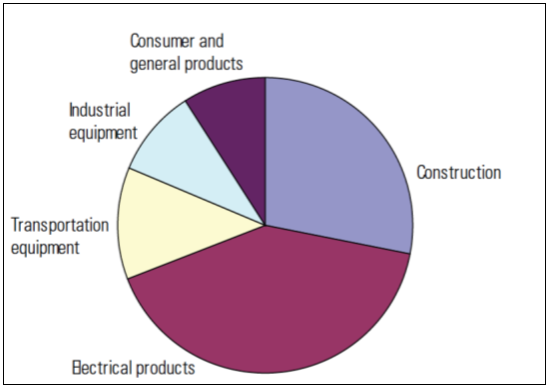
Source: (BGS, 2007)
Cite This Work
To export a reference to this article please select a referencing stye below:
Related Services
View allDMCA / Removal Request
If you are the original writer of this essay and no longer wish to have your work published on UKEssays.com then please click the following link to email our support team:
Request essay removal


